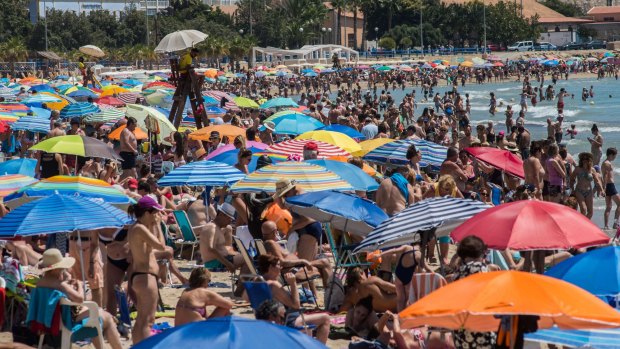This was published 1 year ago
Best time to travel to Europe: With temperatures soaring, this is the season to avoid visiting

A young woman stands under an artificial waterfall as summer temperatures peak in Germany.Credit: AP
Europe is seeing a summer like no other. Vineyards in France are withering in the heat, canal barges are tied up along the Rhine, unable to sail along the river that has ceased to flow. In Italy, the delta of the Po has been inundated by salt water as the river level drops. Pictures have emerged showing Mediterranean beaches under a sky darkened by smoke from wildfires. In the UK the mercury has soared above 40°C for the first time and the grassy lawns of London's Hyde Park look dry and bristly as a coconut shell. They could be an Aussie backyard at the end of a hot, hard summer.
It's far from over. On August 18, the maximum temperature crested at over 30°C across southern Europe with 35 degrees in Rome, 37 in Athens and 44 in Palermo. In Europe's peak holiday season, some have chosen to shift their holidays from the Mediterranean to northern and central Europe, but even in those cities there is no refuge from the heat. For that same August day, Stockholm and London reached 27 degrees and Vienna and Berlin 34. According to Climate Data Org [climate-data.org], those numbers are 5-10 degrees hotter than the average maximum temperatures for these cities in August.

Locals hit the beach as temperatures soar in Spain. Credit: Getty
European cities were not designed for heat waves. Sightseeing becomes exhausting once the temperature rises above 30°C. Tourists have been cooling off in the Trocadero fountain in front of the Eiffel Tower instead of sweating it out on the Champs Elysees, wild swimming in London's Hampstead Heath in preference to panting along Piccadilly. With a few exceptions, air conditioning, like shower design, is not a concept that Europeans have embraced. Where it exists, European-standard air conditioning guarantees restless nights in hotels that absorb heat by day and radiate it by night.
It's not likely to be cooler in 2023. The year 2020 was the warmest ever recorded in Europe. The summer of 2021 broke that record, and 2022's summer will probably set a new high. Given that the trend is toward hotter, drier summers, you can expect something similar in 2023. So what does this mean for a European holiday?
Timing matters
Assuming mid-June to early September could be another scalding summer in Europe, it makes sense to holiday earlier or later. April to early June and mid-September to the end of October could be the sweet spots. If it's a holiday that involves trekking in Corsica or tackling the bike trail around Lake Constance, the extreme ends of those periods might be your best bet.
Less time in cities, more in the countryside could be the go, and anything with water in the picture is going to have extra appeal. Beaches, sure, but European beaches for the most part are small, super crowded and they hurt your feet. European beaches will make you truly grateful you live in Australia. A barge trip along some of the well-shaded canals of France or Britain, an aquatic holiday in Finland's forest-ringed Lakeland or a paddling adventure in Sweden's lake district could be the go. Cruising on the great rivers is another option, but low water levels along the Rhine and Danube could force cruise operators to change their itineraries, as they did when levels dropped in 2018.
Avoid intra-European flights
Extreme heat could impact flight schedules. Flights out of Gatwick were delayed when some passengers fainted after queuing for hours in a non airconditioned terminal. Airport crew
face extra challenges when working outside the terminal in hot weather. Unless it's a flight from one side of Europe to the other, taking a train or getting behind the wheel might be the way to go.
When in Rome…
There is much to admire in the way Italians regulate summer holidays. They might start off with a coffee and cornetto in a local bar before spending a few hours sightseeing, shopping, at the beach or just hanging out. The middle of the day is for a long, leisurely lunch followed by a lie down, which might last until mid-afternoon. In the cool of the evening they will return to the streets and the piazzas, stroll around for a while before having an aperitif and then about 9pm they'll think about eating. It's practical, sensible and perfectly adapted to the summer heat. If you're holidaying anywhere from Lisbon to Crete, you won't go far wrong if you follow their example.
Sign up for the Traveller Deals newsletter
Get exclusive travel deals delivered straight to your inbox. Sign up now.